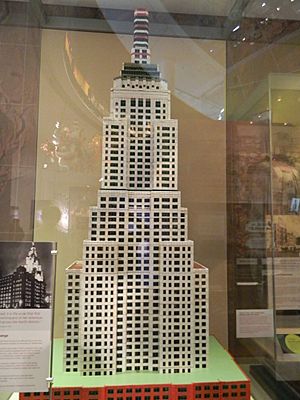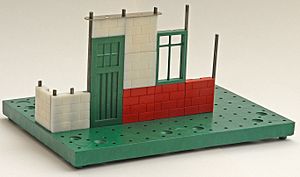Bayko facts for kids
Bayko was a cool building toy from Britain! It was invented by Charles Plimpton, who was an early expert in plastics. Bayko was sold all over the world, especially in countries connected to Britain, from 1934 to 1967. Its name came from "Bakelite," which was one of the first plastics ever made. Many of Bayko's parts were made from this plastic. Bayko was actually one of the very first plastic toys sold anywhere!
How Bayko Buildings Were Made
Bayko was mainly used to build awesome model buildings. Imagine a flat base, usually brown, with a grid of tiny holes. These holes were spaced about 1 centimeter apart. You could stick thin metal rods straight up into these holes. If you wanted to build a really big model, you could connect two or more bases together using small metal links and screws.
Once the rods were in place, you could slide plastic bricks, windows, and other parts between pairs of rods. This created the walls of your building! Other important parts included floors, which were thin sheets with the same grid of holes as the bases. There were also different types of roofs to choose from. Plus, many other special parts were available to make your models unique.
Bayko's Changing Colors and Materials
When Bayko first came out, the bases were large and brown. The walls were brown, maroon, or cream, and the roofs were a deep maroon. Windows were a very dark green. But by 1937, Bayko started using its more famous colors: red or white walls, green windows, and red roofs. The bases were still large and brown.
Big changes happened in 1938 with the "20s series," which added many new parts. Then, in 1939, the "New Series" brought even more new parts and introduced the smaller, more common bases, which were initially a mottled green color.
After World War II, the standard colors became red and white walls, red roofs, green windows, and green bases. These colors stayed mostly the same until 1959. That's when another company called Meccano took over Bayko. Meccano changed the colors again to orange-red and cream bricks, with yellow windows and grey bases.
Over time, Bayko also started using a different type of plastic called polystyrene. This happened gradually from the mid-1950s. Meccano really liked this change because polystyrene was much cheaper to make. Interestingly, right before Bayko stopped being made, they started to go back to the older materials and colors with some new parts called "Flanged" or "Minimalist" parts.
Why Bayko Was Special
Bayko models looked much more realistic than many other building toys of its time. You could build very detailed houses and even famous landmarks!

However, the early Bakelite plastic parts could sometimes break easily. Despite this, Bayko remains a classic and important part of toy history, especially as one of the first plastic building sets.



